Posts Tagged ‘Polymer £20 note’
How to spot a counterfeit banknote!
In 1725, printed banknotes were first introduced in the UK, with the purpose of fixed denominations. The £20 banknote came first and following a shortage of metallic currency during the Seven Years’ War in 1759, £10 and £15 notes were issued.
The £5 note was the last to be introduced in 1793. But since their introduction, banknotes have been subject to fraudulent behaviour, so much so, additional banknotes have been executed partly to make forgery of such more difficult.
Fraudulent notes are also called ‘counterfeit banknotes’ and although less and less are going into circulation — with less than 1 in 40,000 banknotes being counterfeit in 2021 — it’s still an important topic to discuss!
Although polymer banknotes are a lot harder to replicate than the traditional paper ones, you should still check your notes when you receive them. But the questions is, how do you spot a counterfeit banknote?
Sizing
For every polymer banknote, a good starting point is to look at its size.
The higher the value, the larger it is. Here we can see the approximate sizes of the £5, £10 and £20 polymer banknotes:
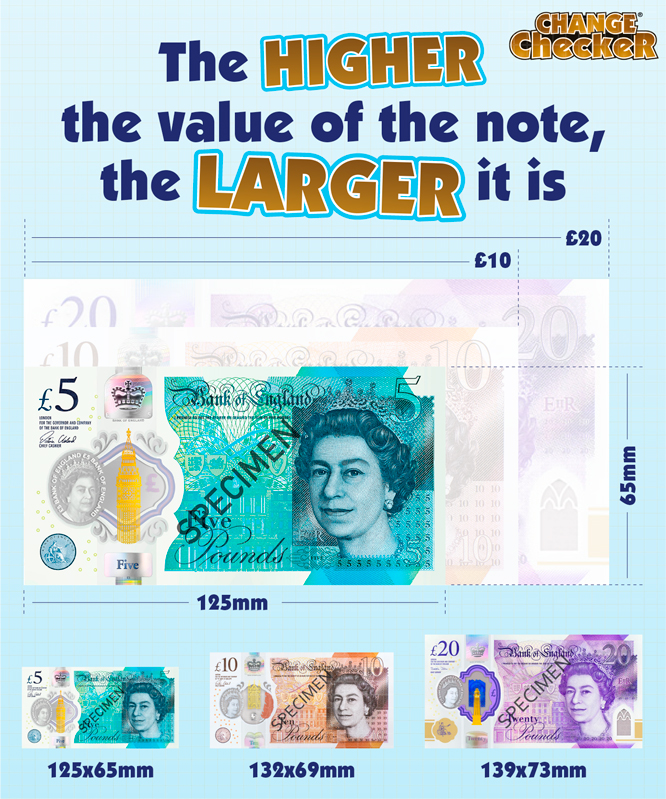
Security Features
Crucially, you should always check your polymer banknotes for the following key security features:
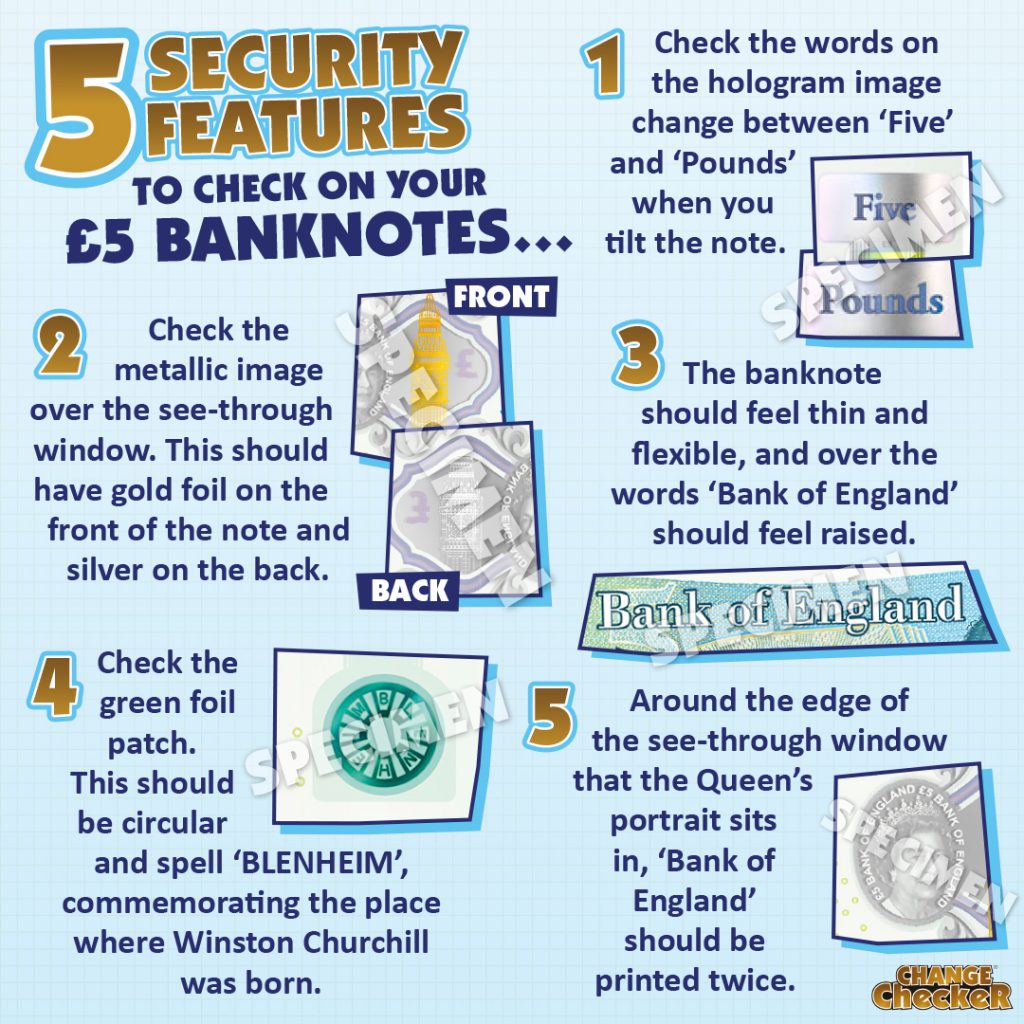
Changing hologram:
- All polymer notes when tilted from side to side and up and down, should feature word changes within their holograms.
- For the £5 banknote, the words should change between ‘Five’ and ‘Pounds’, the £10 banknote between ‘Ten’ and ‘Pounds’ and so on.
See-through windows:
- Each banknote of denomination has a metallic image over the see-through window on it.
- Both the £5 and £10 polymer notes have gold foil on the front of the note within this part and silver on the back.
- The £20 note has a blue and gold foil on the front of the note for the metallic image and silver on the back.
- Lastly, the £50 note has gold and green foil on the front and silver on the back.
Feel of polymer and raised print:
- Polymer is a thin and flexible material so check that the material of your banknote feels this way.
- On each denomination banknote as well, the words ‘Bank of England’ should feel raised.
Foil patches:
- Each banknote denomination will have a different foil patch on it.
- For the £5 note, this is a green foil patch — it is circular and spells ‘BLENHEIM’ to commemorate where Churchill was born.
- The £10 note has a copper foil patch, and this is shaped as a book.
- Check it contains the letters ‘JA’, in tribute to Jane Austen.
- A purple foil patch shaped in a circle with a ‘T’ at its centre, to represent JMW Turner, is imprinted on the £20 note and lastly, a metallic red foil patch can be found on the £50 note and contains the letters ‘AT’ for Alan Turing.
- The patches can all be located behind the silver crown on the front of the notes.
The queen’s portrait in the see-through window:
- The Queen’s portrait which is printed within the see-through window can be found on all the banknotes with the respective denomination and the words ‘Bank of England’ printed twice.
- For example, on the £5 note the inscription ‘£5 Bank of England’ will be printed twice around the windows edge.
This is a just a small selection of the security features that you can find on your polymer banknote. Can you name some of the other features? Let us know in the comments below!
Counterfeit banknotes have no monetary value and cannot be reimbursed. The best thing to do if you encounter a counterfeit banknote is take it to your nearest police station.
They will ask you to fill out a form and once taken from you, will send the suspect note(s) to the National Crime Agency and if found to be counterfeit, to the Bank of England for further examination.
If you’re interested in coin collecting, our Change Checker web app is completely free to use and allows users to:
– Find and identify the coins in their pocket
– Collect and track the coins they have
– Swap their spare coins with other Change Checkers
Sign up today at: www.changechecker.org/app
How much is my polymer £20 note worth?
*** UPDATE ***
With the impact of Covid-19 meaning less people are using cash, it seems older, paper banknotes aren’t being cashed in! According to reports, 24.5 billion paper banknotes are still out there!
Whilst the paper £20 is technically still legal tender, the new polymer notes have been causing quite a stir in the collecting community.
Back in 2016, the first-ever polymer banknote was issued to replace the paper £5 note, with a cleaner, safer and stronger alternative.
Since then, we’ve seen the introduction of the polymer £10, featuring the portrait of Jane Austen and this year saw the issue of the polymer £20 note, featuring JMW Turner’s portrait.
We’ve seen the £5 and £10 notes prove incredibly popular with collectors, with particular notes selling on eBay for way over face value!
But what makes a banknote collectable? Well… It’s all to do with serial numbers!
We previously listed the serial numbers that you should be looking out for on the Polymer £20 note, from AA01 to AK-47, and unsurprisingly, some are proving more popular than others, but which ones are likely to fetch the most on the secondary market?
Well, we’ve done the hard work for you by taking a look at which polymer £20 note serial numbers are selling for the most on eBay and which ones you should be looking out for.
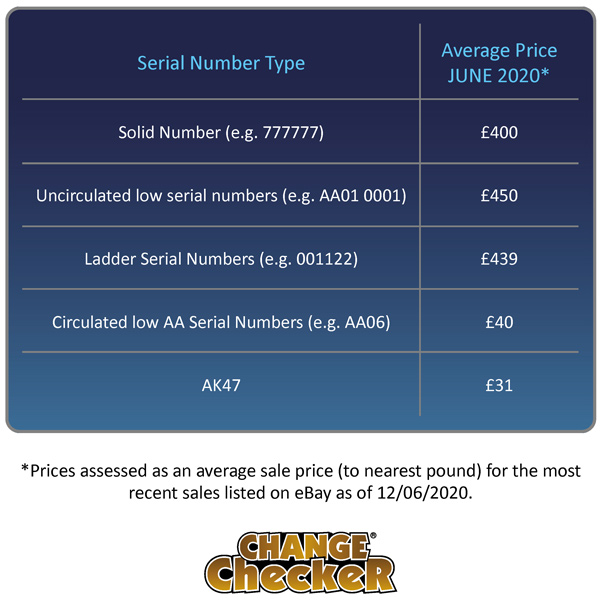
‘Rare’ polymer £20 banknotes
Recurring numbers
If you’ve been lucky enough to find a £20 note with a series of recurring numbers, like the 777777 serial number, you may want to keep hold of it as we’ve seen some which are currently selling on eBay for around £400 – over 20 times its face value!
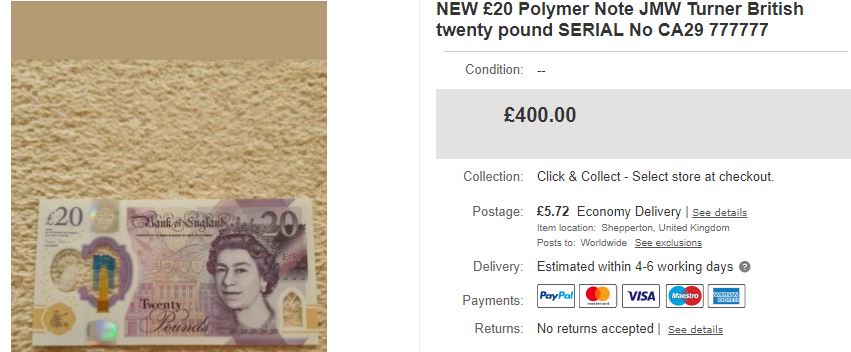
Similar serial numbers have sold for prices within the same range. The 333333 serial number also sold for £400, so it seems collectors everywhere are desperate to get their hands on a recurring number note!
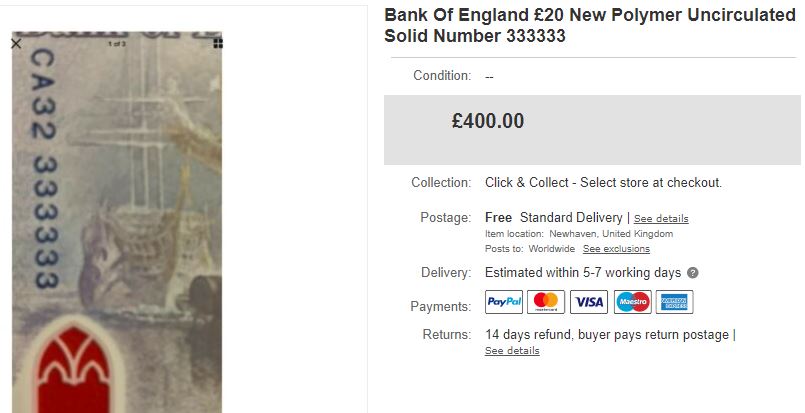
Another type of serial number you should be keeping an eye out for, is a ‘ladder’. These are serial numbers that have consecutive numbers, like this ‘001122’ note.
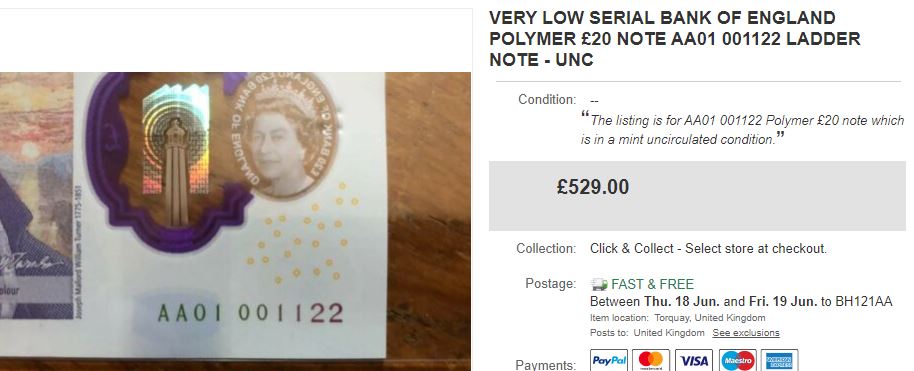
One lucky collector got his hands on this note but at a hefty £529… Other ladder numbers include ‘012345’ and these could currently fetch you a very respectful £350 on the secondary market!
AA numbers
As with previous polymer note issues, the lower serial numbers for the new £20 have proven popular with collectors, with the current average selling price for the AA notes coming in at £40! That’s two times the note’s face value!
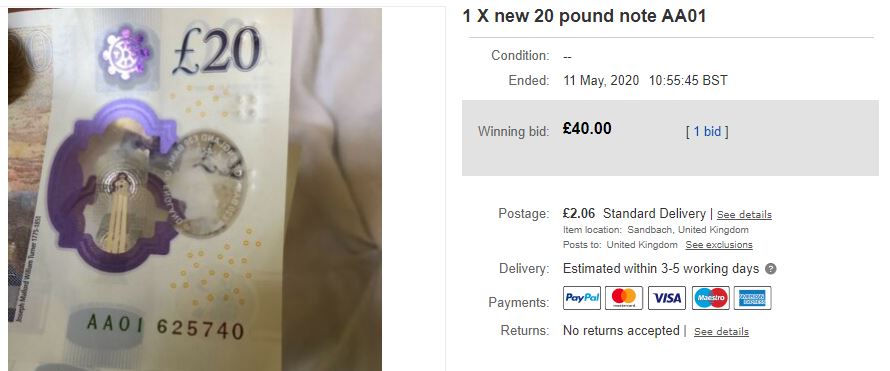
At the annual Bank of England charity auction held at Spink and Son Ltd in London the very first polymer note, the £5, with the serial number AA01 000017 auctioned for £4,150! However, this year, the £20 note with serial number AA01 000010 sold for a staggering £7,500, over FOUR times its starting price!
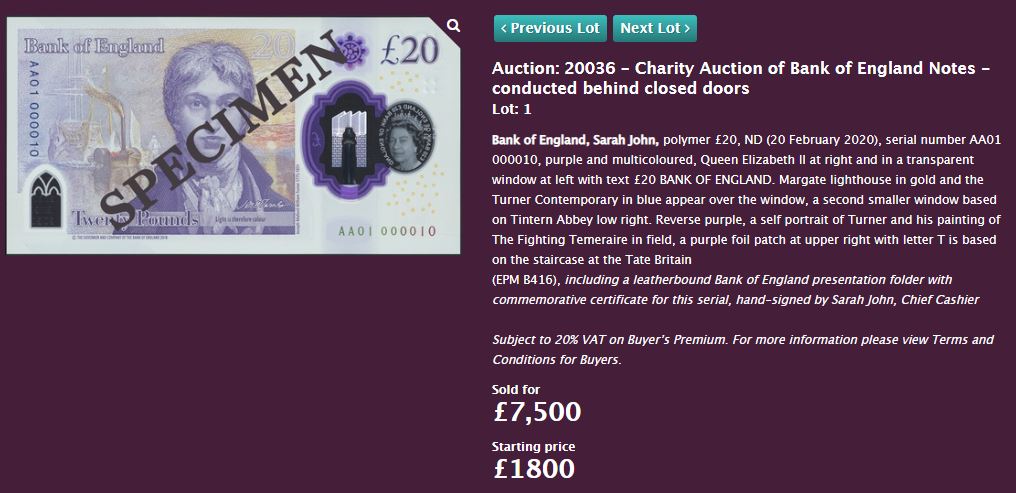
AK47
Considered collectable due to the machine gun connotations, polymer notes with the prefix AK47 were thought to be worth well over face value following the new £5 release in 2016.
A quick look at the most recent eBay sold prices for this serial number, on the new £20 note, show that people are willing to pay £11 over its face value!
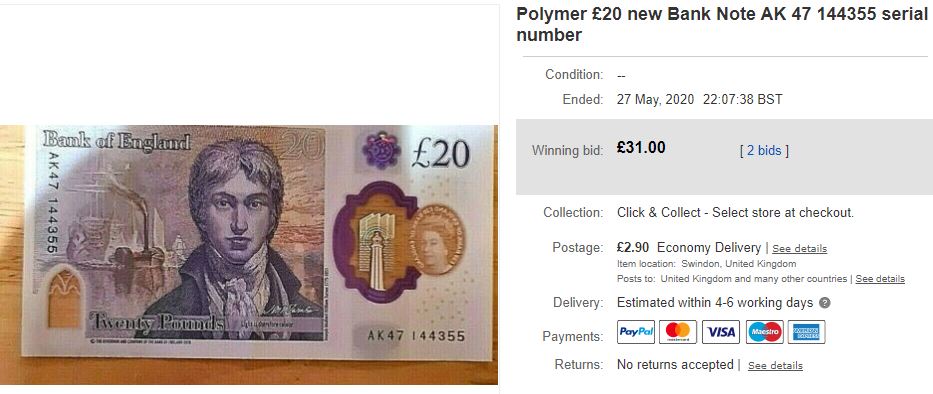
What about the £50 note?
The Bank of England will be issuing a new polymer £50 in 2021 featuring the scientist Alan Turing.

We can’t wait to see the new polymer £50 when it’s issued!
So there we have it, the current selling prices for your polymer £20 notes! With less cash being used during the current climate and therefore less notes in circulation, it’s possible this has added to the collectability of these new polymer £20 notes.
Are you a banknote collector and if so, which notes do you have in your collection? Let us know in the comments below!
If you’re interested in coin collecting, our Change Checker web app is completely free to use and allows users to:
– Find and identify the coins in their pocket
– Collect and track the coins they have
– Swap their spare coins with other Change Checkers

Sign up today at: www.changechecker.org/app
Here’s where you can find the new JMW Turner Polymer £20 note…
Basingstoke
- NatWest, 3 London Street, Old Market Square, Basingstoke, RG21 7NS
Bath
- HSBC, 41 Southgate, Bath, BA1 1TN
- NatWest, 8-9 Quiet Street, Bath, BA1 2JN
Birmingham
- HSBC, 130 New Street, Birmingham, B2 4JU
- Lloyds Bank, 36-38 New Street, Birmingham, B2 4LP
- NatWest, 144 New Street, Birmingham, B2 4NY
- Santander, Unit 6, Caxton Gate, Corporation Street, Birmingham, B2 4LP
- TSB, 134 New Street, Birmingham, B2 4NS
- Virgin Money, Temple Point, 1 Temple Row, Birmingham, B1 5YB
Bradford
- Santander, 9 Nelson Street, Bradford, BD1 5AN
Bristol
- Eurochange, Cribbs Causeway, Bristol, BS34 5QT
Cwmbran
- NM Money, 15 South Walk, Cwmbran, NP44 1PU
Edinburgh
- TSB, 28 Hanover Street, Edinburgh, EH2 2DS
Leeds
- HSBC, 33 Park Row, Leeds, LS1 1LD
- Santander, PR Work Café, 10-12 Park Row, Leeds, LS1 5HD
- Yorkshire Bank, 94-96 Briggate, Leeds, LS1 6NP
Leicester
- Santander, Carlton Park, King Edward Avenue, Narborough, Leicester, LE19 0AL
Liverpool
- Santander, 45 Lord Street, Liverpool, L2 6PB
- TSB, 81-83 Lord Street, Liverpool, L2 6PG
London
- Barclays, 2 Churchill Place, Canary Wharf, London, E14 5RB
- Barry’s Food & Wine, 149 Hoxton Street, London, N1 6PJ
- HSBC, 165 Fleet Street, London, EC4A 2DY
- Halifax, 118-132 New Oxford Street, London, WC1A 1HL
- NatWest, 1 Princes Street, London, EC2R 8BP
- NatWest, 34 Henrietta Street, London, WC2E 8NL
- NatWest, 10 Southwark Street, London, SE1 1TJ
- Post Office, 52 Blackfriars Road, London, SE1 8NN
- Post Office, 39-41 Farringdon Road, London, EC1M 3JB
- Post Office, 11 White Kennet Street, Houndsditch, London, E1 7BS
- Post Office, 19a Borough High Street, London, SE1 9SF
- Post Office, 125-131 Westminster Bridge Road, London, SE1 7HJ
- Santander, 48-54 Moorgate, London, EC2R 6EJ
- Santander, 164-167 Tottenham Court Road, London, W1T 7JE
- Santander, 2 Triton Square, Regents Place, London, NW1 3AN
- The Cooperative Food, 185 Old Street, Shoreditch, London, EC1V 9NP
- TSB, 55 Bow Bells House, Cheapside, London, EC2V 6AT
- Virgin Money, 154-158 Kensington High Street, London, W8 7RL
Manchester
- Lloyds Bank, 42-46 Market Street, Manchester, M1 1PW
- NatWest, 1 Hardman Blvd, Manchester, M3 3AQ
- TSB, 21 Market Street, Manchester, M1 1WR
Margate
- Santander, 110-112 High Street, Margate, Kent, CT9 1JR
Milton Keynes
- Santander, 201 Grafton Gate East, Milton Keynes, MK9 1AN
Newcastle
- Santander, 112-118 Northumberland Street, Newcastle, NE1 7DG
Salford
- Barclays, Unit 2 Blue, MediaCityUK, Salford, M50 2AD
- Lowry Outlet Mall, The Lowry Designer Outlet, Salford Quays, M50 3AH
Sheffield
- Post Office, 12 Ellesemere Road, Sheffield, S4 7JB
- Yorkshire Bank, Fargate, Sheffield, S1 1LL
Swindon
- Nationwide, Nationwide House, Pipers Way, Swindon, SN3 1TA
Wales
- Post Office, 56-58 Oxford Street, Mountain Ash, Mid Glamorgan, CF45 3HB
- Santander, 5-7 Queen Street, Cardiff, South Glamorgan, CF10 2AF


